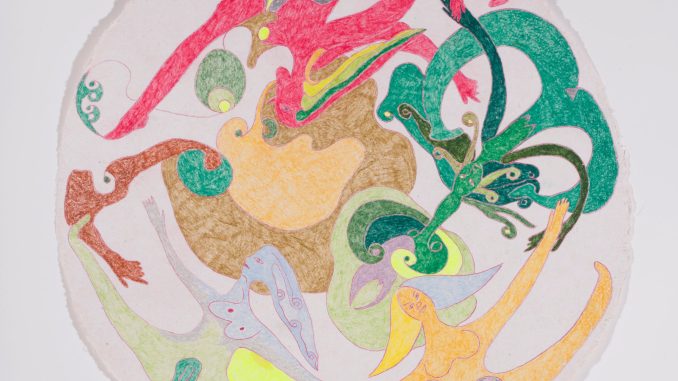
An encaustic beeswax and natural resin-based painting of hexagonal territories, disrupted by windows into a decaying matrix. A burnt wooden pallet holding a cylinder of wire mesh filled with carbonized wood, loose charcoal spilling onto the floor. A hydroponic water circulation system supported by a sculptural network of roots to cultivate a garden of invasive plants, inspired by the tradition of public water fountains and the Greek amphora.
These are among the stories found within the Dorsky Museum’s “In and Out of Lineage: Tracing Artistic Heritage Through SUNY New Paltz Faculty,” an installation running Sept. 7 through Dec. 8 in the Morgan Anderson and Greenberg galleries. The exhibition features work by 20 SUNY New Paltz art and graphic design faculty: Thomas Albrecht, Robin Arnold, Michael Asbill, Lynn Batchelder, Chad Bridgewater, Bryan Czibesz, Andrea Frank, Matthew Friday, Kathy Goodell, Andrea Kantrowitz, Woojin Lee, Rena Leinberger, Kelly McGrath, Myra Mimlitsch-Gray, Emily Puthoff, Nadia Sablin, Aurora De Armendi Sobrino, Suzanne Stokes, Amelia Toelke and Lilly Zuckerman.
The new exhibit is centered around artistic lineage: passing on knowledge from one individual to another, with the artist/educator acting as a conduit between past and future creators. It delves into the dynamic relationship between teaching, creating and illuminating the mutual exchange of knowledge and inspiration between teachers and students.
“‘In and Out Of Lineage’ is an invitation to explore the intricate web of artistic pedagogy and legacy building,” said guest curator Eva Zanardi. “The exhibition delves into a detailed examination of the symbiotic relationship that intertwines creating, teaching and mentoring. It considers the deep-seated link between artistic expression and inherited traditions, examining whether that pedagogical lineage has been preserved or transcended. The exhibition explores whether the exchange adheres to a linear trajectory or manifests through a complex, rhizomatic structure that defies simplistic categorizations.”
Zanardi offered insight into her conception and process for the exhibition in a curator talk at the Dorsky last Thursday afternoon. She shared that her favorite part of the experience was getting to know each of the artists, understanding their practice and process and inviting them to push their boundaries as creators. “I encouraged them to either adapt existing works or produce original pieces that delve into the theme of lineage and the correlation between inspiration and creation,” she said.
Matthew Friday’s “Pharmakon,” a wooden sculpture garden, draws inspiration not only from a line of descendants or origins, but a constellation of influences, ruptures, rebellions, accidents, betrayals and emergences. It includes Donna Haraway’s feminist studies of science, Donella Meadows’ systems theory, the rhizomatic philosophy of Gilles Deleuze, utopian science fiction and the abundant creativity found in non-human agents.
“I am inspired by the resilient and entangled nature and culture of urban environments, especially the arbitrarily maligned ‘invasive’ plants that thrive and transform the sacrifice zones designated by colonialist and capitalist projects,” Friday said.
His “In and Out of Lineage” piece also pulls on the ancient Greek concept of the “pharmakon” as an ambiguous term connoting plants that acted as both poison and cure — agents of change meant to mediate between the worlds of human, non-human and divine — or reference to sacrifice, something surrendered so that change could take place. Friday’s project reactivates these latent meanings through sculpture.
“Post-industrial sites, such as those around SUNY New Paltz, were initially designated as sacrifice zones for capitalist progress,” he said. “These urban environments are dense with weedy plants who, via complex entanglements, are continuously transforming the inhospitable hardened surfaces of concrete, asphalt and highly compacted deadened soils into thriving ecosystems. These weeds, arbitrarily maligned so-called ‘invasives’ that have been cast out of the proverbial garden of Eden by the nativist policing of purity, are the very plants that thrive and transform our disturbed urban ecologies into something astonishing.”
The plants being grown in his work serve as the basis for ongoing experimentation and workshops. A galvanic sensor measures the electrical signals transmitted by the plants, which are then sent to a processor that turns them into ambient sound waves. “If you listen closely, you can hear the plants speaking to you,” Friday said.
In addition to finding inspiration for their own creation, “‘In and Out Of Lineage’ invites contemplation of educators’ influential role in sculpting future generations of artists while simultaneously being shaped by their interactions with students,” said Zanardi. “It is a testament to the transformative power of education and the enduring impact of those who create, teach and inspire.”
Thomas Albrecht is the artist behind the live performance featured during the opening event on Sept. 7, entitled “Slide Show.” Albrecht’s performance is a contemplation of memories with his mother, now slipping rapidly into dementia. It involves several physical elements: a collapsable card table from his grandparents’ lake home in Minnesota, a slide projector and a simple folding chair. Each physical element and the idea of live performance points to the temporary status of his work, as with the fleetingness of the human and the mind. He understands the value of the reciprocal relationship between teacher and student.
“Few of us, if any, move through the world alone,” he said. “I enter my classroom as an educator along with all the souls that have taught me, supported me and challenged me to think anew about the world, my place in it and my responsibility for it. There is a lineage of thought that runs through me to my students, connecting them to the words, images and ideas that I pass to them. I believe this legacy of connection is at the foundation of learning.”
“In essence, artists who are also educators embody a dual creative force,” said Zanardi. “They not only bring new artistic visions to life but also cultivate the creative capacities of their students, ensuring that the cycle of creation continues and evolves. This dual role enriches both their own practice and the broader artistic landscape, making them creators in the truest and most expansive sense.”
